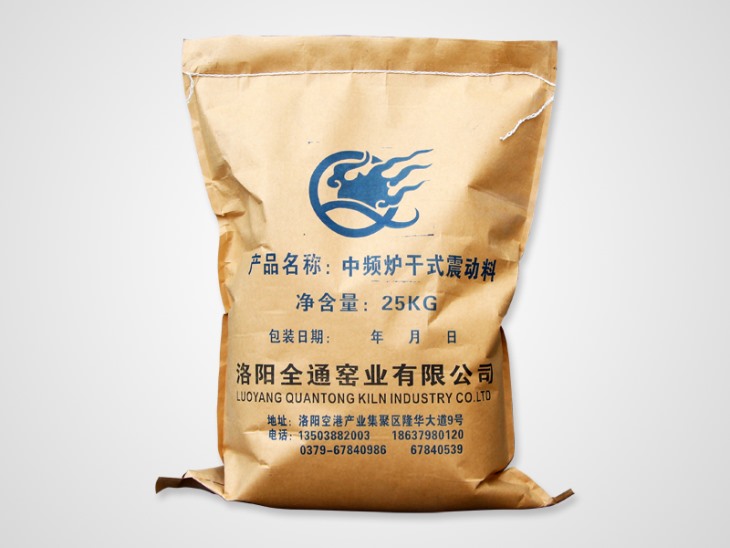Why does the intermediate frequency furnace lining have cracks?
Today, the professional intermediate frequency furnace lining manufacturer of Luoyang Quantong Kiln Industry Co., Ltd. will take you to understand the reasons why the intermediate frequency furnace lining has cracks:
Metal fins penetrate into the section of the furnace lining and cause damage to the furnace lining. The metal fins are caused by cracks in the furnace lining infiltrating the molten metal. There are three types of cracks:
A) Transverse cracks are caused by the layering of the lining material when the furnace is built, or the loosening of the furnace lining due to the structure of the furnace. Layering: When vibrating and tamping, small particles (especially powdery materials) will form thin particles on the concentrated surface. The powder layer has very low strength. If there is no raking when feeding again, the upper layer will be layered after tamping. In order to prevent stratification during the furnace building process, the surface of each layer should be loosened (about 20mm) before feeding. The thickness of each layer of charge should be adjusted according to the furnace building method and the furnace building tools used (the thickness of each layer of charge should be 60-80mm when using electric furnace building tools). The bottom of the large furnace and the lower part of the side wall are The addition of the lining material (when the thickness of the material is greater than 500mm) requires the addition of a funnel to prevent particle segregation during the falling of the lining material. Another possible cause of transverse cracks is that the lining near the tap hole is quilted when the furnace is cooled. Cracks occur when the furnace lining cools and shrinks due to adhesion and hanging.
Lifting furnace: The heat preservation molten iron is too low, causing the upper molten iron to condense. When high power is used again, the lower molten iron (the temperature rises rapidly) will lift the upper cooling material upward, thereby driving the transverse crack of the charge. Its inner and outer contours are the same as those of the refractory material of the upper furnace ring, which is convenient for the furnace lining to slide down freely when it cools and shrinks without being caught.
B) Vertical cracks (longitudinal cracks)
When the furnace lining is cooled down after being impacted by a sharp cooling cycle, large radially dispersed longitudinal cracks (ie vertical cracks) will appear on the entire furnace lining. In the subsequent heating and smelting process, the molten metal will pass through the The cracks that can be bridged penetrate into the hot surface, and freeze in the section to form metal fins. Reduce the impact degree of the cold and heat cycle, and choose a reasonable lining cooling and heating program (the old lining should have a suitable temperature rise after preheating and then charging and melting. Curve), when the furnace capacity is 4-15 tons, the heating rate does not exceed 150 degrees Celsius\/h, and if it is greater than 15t, it does not exceed 100 degrees Celsius\/h.
C) Random cracks are caused by damage to the lining material during demolding or unreasonable inclination of the lower part of the crucible mold and the existence of an acute angle.
The above is the analysis of the causes of cracks in the intermediate frequency furnace lining

Previous: Cause Analysis of Damaged Refractory Material of Submerged Arc Furnace Lining
下一条: Analysis of Corrosion Phenomenon of Furnace Surface Lining
Related Industry Knowledge
- Features and Benefits of Coil Clay
- What are the advantages of a good furnace lining
- Misunderstandings in the use of ramming materials in intermediate frequency furnaces
- Phenomenon analysis of failure of argon blowing of ladle permeable bricks and how to improve the rate of argon blowing
- Where is the consumption reduction and energy saving of breathable bricks reflected?
- How to improve the service life of intermediate frequency furnace lining
- Reasons for damage to intermediate frequency furnace lining and how to solve them
- The performance and advantages of breathable brick
- Analysis of Structural Characteristics of Dispersive Breathable Bricks
- The intermediate frequency furnace charge knotting process needs to pay attention to details sharing
- Cause Analysis of Damaged Refractory Material of Submerged Arc Furnace Lining
- Will the ramming material attack chemically?
- Do you know how to choose the correct acid furnace lining
- How to repair the electric furnace lining
- What should be paid attention to when lining the furnace
- Introduction of ramming material for intermediate frequency furnace
- Influence of medium frequency electric furnace lining material
- How to build furnace and sintering process for intermediate frequency furnace lining materials
- Intermediate frequency furnace ramming material
- How to properly maintain the furnace lining


